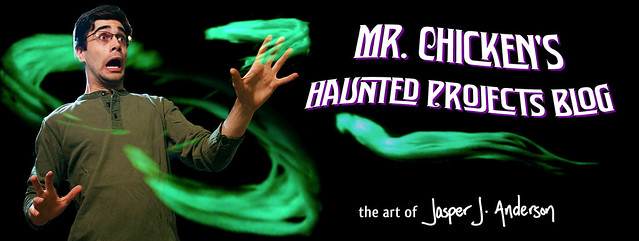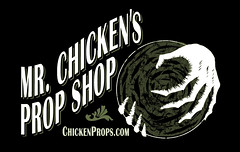I've shared quite a bit about my paper towel and latex paint corpsing technique, but I don't believe I've shared the origins. The paper towel idea came from a site called DeathLord.net. Here's an archive of the tutorial. The site is no more. www.deathlord.net ARCHIVE
| The DeathLord.net Rotting Corpse |
What's awesome is that when I go back and read it, he learned the trick from someone else in 1997!
The earliest archive is from 2004, but I believe it's older than that, because I know I had studied this for some time before I finally got my own Blucky to work with. That's another thing, by the way, you kids don't know how easy you have it with these fully detailed skeletons for $20-$30. Back in my day, you could either get a "Blucky" from Big Lots for $7.77 (later $8.88, $9.99, and so on-- I kid you not), or a fully accurate Bucky from Anatomical Chart Company for a pretty penny. But I digress.
This is the zombie guy I made in 2005, based on that tutorial, but with paper towels dipped in flour/water mix, and plaster bandages for the neck, as I recall. If you want to see how this guy in the coffin evolved into my first Wacky Zombie, check out this post.
Now, how did I come across that site in the first place? There was an awesome resource called The Monsterlist of Halloween Project Links, curated by Mark Butler. He actually has a little info page on how the link list was born out of the Halloween-L mailing list in 1999 (was that the first online haunters' group?). The Monsterlist is still there (here), but it looks like it hasn't been updated since about 2014.
For me, the Monsterlist was the big thing. Before Facebook and Youtube, and even the forums, this was how you found out what people were building.
The page is organized alphabetically, with just a title of the project and a short description, so if you were looking for something in particular, command+F was your friend. It was always exciting when you checked back on the page to find it had been updated with a slew of new tutorial links, which might be a couple times a year.
Incidentally, Mark Butler did some how to's of his own, and I used one as the inspiration for my first animatronic talking skeletons in 2005.
All this to say, let's remember to look back on where our favorite projects come from. Any time you're making something, you're building on the ideas someone else was kind enough to share and explain about their tools, materials, and processes.



No comments:
Post a Comment